
Where it all begins | Charlotte Hsu
ONONDAGA NATION — In the hands of craftsman Alf Jacques, wood bends and changes in ways it won’t for other men.
From logs of pale, white hickory, he conjures beauty, grace. He splits, steams and shapes the timber until something exquisite emerges–something that gleams.
Jacques, 63, is a famed maker of wooden lacrosse sticks. He has been in the trade for half a century, since his father walked him through the forests of the Onondaga reservation south of Syracuse and helped him pick a tree.
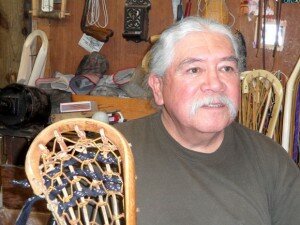
Alf Jacques | Charlotte Hsu
“I was about 13 years old, and we were playing lacrosse here on Onondaga Nation, and the local Indian guys were running around playing,” Jacques remembers. “I didn’t have my own stick, and they cost about $4 or $5 apiece at the time, and we didn’t have any money.
“So my father says, ‘What the heck? Let’s make our own.’ So we went into the woods, found a tree and started making sticks.”
The time that Jacques has poured into his craft has made him not only a master artisan, but a keeper of a centuries-old tradition indigenous to Upstate New York.
Lacrosse may elicit thoughts of prep school, but the game is an ancient North American Indian sport. Its inventors included the Iroquois, a confederacy of six Native American nations whose territory once stretched from Lake Erie in the west to Lake Champlain in the east.
Jacques is a member of Onondaga, one of the Iroquois nations. To his people, lacrosse is sacred–a gift, they say, from the Creator.
An annual spring game at Onondaga Nation pulls the community together, with 7- and 8-year-old boys playing alongside men in their 70s, Jacques says. The event begins with a thanksgiving to the Creator.
At any time of year, special games may be called to channel the people’s energy to help heal the sick–a concept Jacques compares to prayer in other cultures.
As played in these traditional settings, lacrosse is not the game that most Americans know, but something less restrained. There are no lines on the field, no boundaries, no whistles and no referees, Jacques says. The players don’t wear helmets, pads or gloves. The Onondaga call lacrosse Deyhontsigwa’ehs, which translates roughly into English as “they bump hips.”
In these games, the wooden lacrosse stick is essential. It holds the spirit of the tree, connecting the players with Mother Earth in a way that plastic sticks just can’t, says Jeremy Thompson, a rookie on Buffalo’s professional indoor lacrosse team, the Buffalo Bandits.
Thompson, an Onondaga, is among young people who have expressed interest in learning Jacques’ trade. Of the apprentices that Jacques has mentored over the years, one is still making sticks. Others have quit; not everyone is prepared for the grueling work the craft requires, Jacques explains.
The hickory logs he uses come from trees at Onondaga Nation. He splits each log lengthwise into narrow wooden staffs, which he then shapes, dries, steams, bends, sands and shellacs.
The result is a wooden stick with a crook on one end, the shape of a cane or question mark. The pale, blonde wood is polished to the texture of silk. Other parts include a leather and nylon netting, where the ball sits, and a sidewall woven from handmade cowhide strings.
The entire process involves about two dozen steps spanning at least eight months. As a result, Jacques’ workshop is filled with lacrosse sticks in various stages of completion, from whole logs piled just outside to gleaming, finished products within. The set-up gives the place a feeling of metamorphosis.
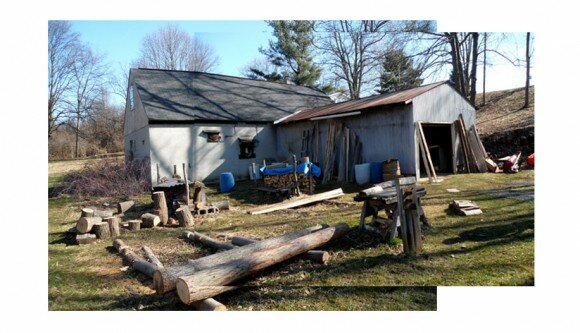
The Jacques workshop | Charlotte Hsu
Onondaga Nation is a three-hour drive from Buffalo, off Exit 39 of the New York State Thruway. Along the way, the scenery shifts from farms to woodlands as the roads float past the Fingerlakes and carry visitors into the Iroquois heartland.
Jacques’ workshop is on Onondaga Nation, below a short but steep hill opening onto a clearing behind his mother’s house. It’s here, in this spacious two-room building, that he and his father, Louis, mastered their craft through years of trial and error.
In the beginning, “We made a lot of ugly sticks,” Jacques remembers. But once the father-and-son team perfected their technique, the market for their product was huge. They produced as many as 11,500 sticks a year, employing several workers and selling to men, women, boys and girls, Jacques says.
Then, in the 1970s, plastic sticks came into vogue, and demand dried up. Louis went to work stringing plastic heads to supplement his income. Jacques found a job as a machinist, making rocket engine parts for Allen Tool.
Even as they took outside employment, the stickmakers refused to give up their trade. After Louis died in 1985, Jacques maintained the family business alone. He emerged from the lean years with a new business model, a new clientele.
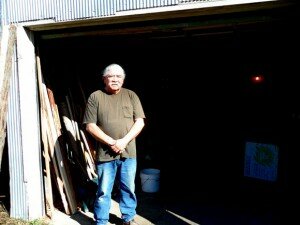
Alf Jacques at Onondaga Nation | Charlotte Hsu
Today, he makes about 200 sticks a year. They sell for $250 apiece, and the buyers include native players, as well as teams around the world who purchase the sticks as awards for outstanding coaches and athletes.
Though Jacques remains loyal to wood, he is more thoughtful than upset as he discusses the proliferation of plastic. He sees an upside to the changes: “Lacrosse spread more because of the plastic sticks,” he says.
“If everyone used a wooden stick today, who’s playing?” he asked. “If everybody used wood, there would be no more hickory trees.”
The ease of manufacturing synthetic sticks helped lacrosse explode from a little-known sport into an international phenomenon–an evolution Jacques has observed during his lifetime.
The success is a point of pride. Pro-lacrosse may have more rules than the original, Indian version, but ultimately, “it’s still our game,” Jacques says. Like his father, he has played and coached lacrosse for organized teams, serving as goalie at one point for the professional Syracuse Stingers.
For more than 150 years, the Iroquois–or the Haudenosaunee, meaning People of the Longhouse, as they call themselves–have played a major role in popularizing the game.
The confederacy consists of the Mohawk, Oneida, Onondaga, Cayuga, Seneca and Tuscarora nations. Though many American Indian nations had ball sports, it’s the Iroquois variant that grew into what we know as modern lacrosse, according to a history of the sport by scholar Donald M. Fisher.
White men and Mohawk Indians played their first recorded match in 1844 in Montreal, Fisher wrote in his book, Lacrosse: A HIstory of the Game.
Today, the sport is one of America’s fastest-growing, and the popularity presents opportunities for young Iroquois like Thompson to attend top colleges and play professionally.
Syracuse University, Thompson’s alma mater and a lacrosse powerhouse, is one organization that has benefited from Iroquois talent. The Buffalo Bandits are another example.
With the Iroquois population dispersed among reservations in New York and Canada, lacrosse has become an expression of sovereignty.
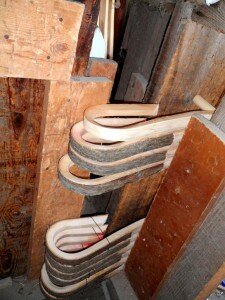
In progress | Charlotte Hsu
One task entrusted to Jacques is making sticks for the Iroquois Nationals, who represent the Haudenosaunee in international competition.
The team travels on Iroquois passports and plays against opponents including the United States and Canada. In a field representing 21 countries, the Nationals came in fourth in the 2006 World Lacrosse Championship.
When the team was banned in 2010 from flying to the tournament in England with native passports, the players declined a recommendation travel on American or Canadian passports, said Ansley Jemison, the general manager at the time.
“We’re not U.S. citizens,” Jemison explains, noting that the team draws players from the U.S. and Canadian sides of the border: “We’re actually a sovereign nation.”
When the Nationals refused to compromise, “Everybody I know supported them,” says Jacques, who takes pride in his contribution to the team.
“I like to be a part of it. I like to push the wood factor, you know? … They’re proud to walk out on the field with a wooden stick,” he says. “That’s where the game came from–from us, the Iroquois.”
The wooden stick is part of the soul of the game. Male Onondagas traditionally receive one at birth, and those who have died carry one in their casket. The game continues in the spirit world, where men play with their ancestors, Jacques says.
That’s what sets his sticks apart–not just his workmanship, but his lifelong reverence for the game.
Robert Salonga, a crime and public safety reporter for the Contra Costa Times in the San Francisco Bay Area, edited this story. For more information on lacrosse and the Iroquois, read this brilliant story from Sports Illustrated: Pride of a Nation



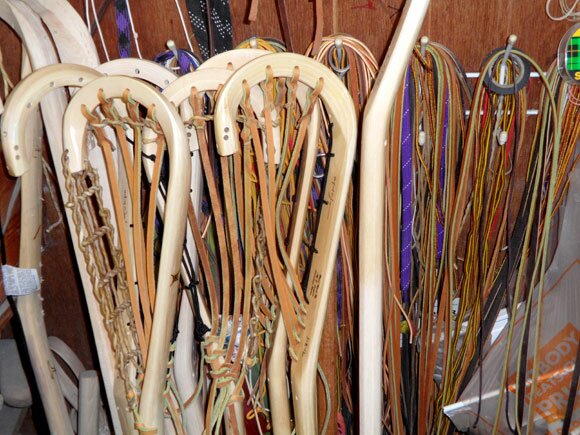
Loved the combination of photos and story and the incorporation of the history and current events related to lacrosse. Wonderful portrayal of a dedicated craftsman. I will definitely bring this article to the attention of Donna and Bill who attend Syracuse lacrosse games.
Do you sell your sticks. I grew up playing with a wooden stick. I am interested in about 10.
Sandy
I’ve been looking to buy a traditional wooden stick but cant seem to find a place or website that sells them. Was wondering if anyone could help find where i could buy one. Thank you
Call Tama Lacrosse in Naperville, Illinois. They carry Onondaga Wooden Box Lacrosse Sticks.
I was wondering if there was a possible way to order one of your handcrafted sticks. I have always wanted to try playing Lacrosse with one.
I play in high school and I would love to own one
I was wondering if there is a way to by one of these so I can show my team my culture
I always wanted one of those old lax stick do u sell them or know who dos sell them
I love lacrosse and I love the real lacrosse sticks and I was wondering how I could get one to play with?
I’m looking to purchase a good quality wooden lacrosse stick. Can anyone tell me where I can purchase one
I live in Toronto, Canada
I was trying to buy a wooden lacrosse stick for my husband. He has been coaching high school lacrosse for 18 years and is retiring from coaching. He played lacrosse when he was in high school and has always loved the sport. And has enjoyed many years of coaching lacrosse. I would love to surprise him with a wooden stick. Please let me know where I can buy one. Thank you.
Did anyone get a reply for the opportunity to purchase these beautiful sticks?
Can they be used in collegiate play and are they made for women’s lacrosse also
I would like to buy some sticks off alf Jacques too?? Can anyone tell me how i’d go about that
how much are they and could i buy one
p.s they are an amazing work of art nice job wow
will you sell these or does anyone one know where i can buy one?
I was wondering if I could purchase one of these sticks
I would love to be able to surprise my husband with an Alf Jacque hand carved lacrosse stick. He has coached lacrosse for 2 decades and has played his whole life – club, high school, college levels. He deserves a stick like this and I would love to get him one for his birthday. how can I order?
Can we buy these
i love my stick but its getting beat up bad i was woundering how i can get one of yours
Sir,How do I go about purchasing one of your sticks ?
i was wondering if there is a weight difference between the woodies and plastics?
Another story of opportunity missed by native peoples.
1) They opted not to play in England even though a sensible alternative to native passports existed? That is just pride. A sin in most cultures. Suck it up and kick butt, don’t sit home and sulk.
2) They promote the stick, they advertise the stick, but they cannot seem to make the stick in a timely fashion. That is just incompetence and bad business. Also a sin.
The wait time for the native stickmakers to fulfill an order for a single stick is up to 2 years. Prices can be over $200. Seriously? Two years? You can’t lay in several hundred staves for drying and bending in a month? Do that for several months and you have enough blanks to fulfill orders that trickle in the following year.
I order a traditional osage longbow every year and it arrives in 4 weeks or less. The staves were cut, sealed, set to dry years ago. They are graded, and roughed out and waiting for specs on length and weight for the shooter. The bow arrives tuned, balanced, beautifully finished and on time. One year I had to wait 6 weeks cuz the bowyer was on a fishing trip.
Making a wooden stick should take all 3 days if you have your materials properly graded and prepared. If you are always going to start from cutting of a tree when an order comes, you need a better business model.
And don’t tell me its not a business. They advertise, pitch, position, tout and charge $200 or their product. They have company names and vendor websites (albeit very poorly laid out and with no prices listed or ways to order online).
The maker does not imbue the stick with any special magic. That comes the first time you score on a stronger opponent. Get out there and count coup!
I would love to buy my husband one of your sticks for our 50th wedding anniversary. He played lacrosse at SU and fondly remembers playing the Onondagas. I went to Valley with Judy Lewis and B George-they were friends. Now our grandkids play in Ca. Could you phone me with prices etc.? We share an email and I’d like it to be a surprise. 315-357-4381.
Thanks!
Hello,
I played lacrosse at school. I would be thrilled to buy one made
of wood, from your shop. Please let me know how to start this process.
Thank you very much.
All the best,
Andrea Wilder
I would really want to buy one of these please email me if it’s possible I’ll pay what ever it costs
Would absolutely love to buy an Onondaga wooden box lacrosse stick for my grandson who lives and breathes lacrosse. Please tell me where they may be purchased. Thank you!
Hello I watched a video of you on youtube and I was wondering if you sold wooden lacrosse sticks and if so how much.
Mr. Jacques: In 1972, I came to your father’s place and got a defenseman stick-nicknamed, “Louis” by my teammates at West Point. As best I can recall, Steve and Charlie Wood (lafayette, NY) brought me to your father. In Feb/Mar 1973, I traveled from Long Island to the house and bought another-I still have it. wanted to say thanks for helping me achieve my lacrosse goals-couldn’t have done it without my “Louis”.
Tom O’Leary
USMA Class of “74